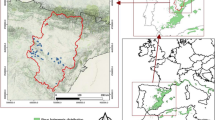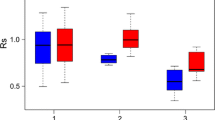Abstract
Nothofagus antarctica is the most representative species of the native mixed forest occupying ecotone areas between forests and steppe in NW Patagonia, South-America. In this type of environment, vulnerability to climate change is particularly enhanced. Predictions of future climatic conditions for this region indicate an increment of atmospheric temperature and also, a high variability of rain events, threatening forest persistence and productivity. In this framework, management strategies are crucial to guarantee sustainability of native vegetation systems. The objective of this study was to study the effect of tree density on the ecophysiological limitations of water use of N. antarctica, as a proxy to its productivity, during a drought period. Compared with the unthinned forest, the thinned forest showed higher soil water availability, higher sapflow density (Js) and canopy conductance (Gc) values, similar aerodynamic conductance (Ga) and a low degree of coupling to vapor pressure deficit. Ecophysiological results demonstrated a high limitation over gas exchange of individual N. antarctica trees imposed by the resistance in the hydraulic soil-to-leaf pathway in the unthinned-natural condition. Surprisingly, our results suggest structural limitations in the unthinned stand which reduce the ability of N. antarctica trees to take advantage of wet seasons, at least in the short term. Thinning could decrease the susceptibility of N. antarctica-based systems to drought stress, by increasing resource availability to the remaining trees, thus contributing to enhance the persistence of this species under climate change conditions.






Similar content being viewed by others
References
Bovard BD, Curtis PS, Vogel CS, Su H-B, Schmid HP (2005) Environmental controls on sapflow in a northern hardwood forest. Tree Physiol 25:31–38
Bréda N, Granier A, Aussenac G (1995) Effects of thinning on soil and tree water relations, transpiration and growth in an oak forest (Quercus petraea (Matt.) Liebl.). Tree Physiol 15:295–306
Bucci SJ, Scholz FG, Campanello P, Montti L, Jimenez M, Rockwell F, La Manna L, Goldstein G, Holbrook MN, Guerra P, López Bernal P, Enricci J (2006) Convergencia funcional en la arquitectura hidráulica y en las relaciones hídricas de especies y poblaciones de Nothofagus de Argentina y Chile. XXII Reunión Argentina de Ecología, Córdoba, August 22 to 25th, Argentina, p 78
Fernández ME, Gyenge JE, Schlichter TM (2009) Water flux and canopy conductance of natural vs. planted forests in Patagonia, South-America. Trees 23:415–427
Gallopín GC (1978) Estudio ecológico integrado de la cuenca del Río Manso superior (Río Negro, Argentina). I. Descripción general de la cuenca. Anales de Parques Nacionales XIV:161–230
Gracia CA, Sabaté S, Martínez JM, Albeza E (1999) Functional responses to thinning. In: Roda F, Retana J, Gracia CA, Bellot J (eds) Ecological studies, vol. 137. Ecology of mediterranean evergreen oak forests. Springer, Berlin, pp 329–338
Granier A (1985) Une nouvelle méthode pour la mesure du flux de séve brute dans le tronc des arbres. Ann Sci For 42:193–200
Granier A, Biron P, Lemoine D (2000) Water balance, transpiration and canopy conductance in two beech stands. Agric For Meteorol 100:291–308
Gyenge J, Fernández ME, Sarasola M, Schlichter T (2008) Testing a hypothesis of the relationship between productivity and water use efficiency in Patagonian forests with native and exotic species. For Ecol Manage 255:3281–3287
Gyenge J, Fernández ME, Sarasola M, Schlichter T (2009) Effects on site water balance of conversion from native mixed forest to Douglas-fir plantation in N.W. Patagonia. New For 38:67–80
Jarvis PG, McNaughton KG (1986) Stomatal control of transpiration: scaling up from leaf to region. Adv Ecol Res 15:1–49
Laclau P (1997) Los ecosistemas forestales y el hombre en el sur de Chile y Argentina. Bol. Téc. FVS-WWF/US 34, p 147
Licata J, Gyenge JE, Fernández ME, Schlichter T, Bond B (2008) Increased water use by Ponderosa pine plantations in northwestern Patagonia, Argentina compared with native vegetation. For Ecol Manage 255:753–764
Lu J, Sun G, McNulty SG, Amatya DM (2005) A comparison of six potential evapotranspiration methods for regional use in the South-Eastern United States. JAWRA 41:621–633
McCarthy JJ, Canziani OF, Leary NA, Dokken DJ, White KS (2001) Climate change II: impacts, adaptation and vulnerability. http://www.grida.no/publications/other/ipcc%5Ftar/?src=/climate/ipcc_tar/wg2/index.htm
McDowell NG, Adams HD, Bailey JD, Hess M, Kolb TE (2006) Homeostatic maintenance of ponderosa pine gas exchange in response to stand density changes. Ecol Appl 16:1164–1182
Monteith JL, Unsworth MH (1990) Principles of environmental physics. Edward Arnold, New York, p 191
Oren R, Phillips N, Ewers BE, Pataki DE, Megonigal JP (1999) Sap-flux-scaled transpiration responses to light, vapor pressure deficit, and leaf area reduction in a flooded Taxodium distichum forest. Tree Physiol 19:337–347
Pataki DE, Oren R, Smith WK (2000) Sap flux of co-occurring species in a western subalpine forest during seasonal soil drought. Ecology 81:2557–2566
Phillips N, Oren R (1998) A comparison of daily representations of canopy conductance based on two conditional time-averaging methods and the dependence of daily conductance on environmental factors. Ann Sci For 55:217–235
Reque J, Sarasola M, Gyenge J, Fernández ME (2007) Caracterización selvícola de los ñirantales de la cuenca central del Río Foyel (Río Negro, Patagonia Argentina). Bosque 28:33–45
Sarasola M, Fernández ME, Gyenge JE, Peyrou C (2008) Respuesta de los ñires al raleo en la cuenca del Río Foyel. EcoNothofagus 2008, Segunda Reunión sobre Nothofagus en la Patagonia, 22 al 24 de abril del 2008, Esquel, Chubut, p 47
Somlo R, Bonvissuto G, Schlichter T, Laclau P, Peri P, Alloggia M (1997) Chapter 7: silvopastoral use of argentine patagonian forest. In: Gordon AM, Newman SM (eds) Temperate agroforestry systems. CAB Internacional, Cambridge, p 269
Suárez ML, Kitzberger T (2008) Recruitment patterns following a severe drought: long-term compositional shifts in Patagonian forests. Can J For Res 38:3002–3010
Timmermann A, Oberhuber J, Bacher A, Esch M, Latif M, Roeckner E (1999) Increased El Niño frequency in a climate model forced by future greenhouse warming. Nature 398:694–697
Villalba R, Veblen TT (1998) Influences of large-scale climatic variability on episodic tree mortality in Northern Patagonia. Ecology 79:2624–2640
Wullschleger SD, Wilson KB, Hanson PJ (2000) Environmental control of whole-plant transpiration, canopy conductance and estimates of the decoupling coefficient for large red maple trees. Agric For Meteorol 104:157–168
Zweifel R, Steppe K, Sterck FJ (2007) Stomatal regulation by microclimate and tree water relations: interpreting ecophysiological field data with a hydraulic model. J Exp Bot 58:2113–2131
Acknowledgments
We gratefully acknowledge the members of the Forest Ecology Group of EEA Bariloche INTA for their support in field and laboratory measurements. We thank G. Dalla Salda and an anonymous reviewer for their helpful comments for content and language improvement. This project was funded by a Regional Research Grant of INTA (PATNO13) and PICT 08-14692 of FONCYT-SECyT, Argentina.
Author information
Authors and Affiliations
Corresponding author
Additional information
Communicated by G. Wieser.
Rights and permissions
About this article
Cite this article
Gyenge, J., Fernández, M.E., Sarasola, M. et al. Stand density and drought interaction on water relations of Nothofagus antarctica: contribution of forest management to climate change adaptability. Trees 25, 1111–1120 (2011). https://doi.org/10.1007/s00468-011-0586-2
Received:
Revised:
Accepted:
Published:
Issue Date:
DOI: https://doi.org/10.1007/s00468-011-0586-2




